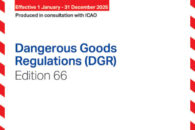 In late July, the International Aviation Transport Association (IATA) released a summary document in reference to the changes that will appear in the 58th edition of their Dangerous Goods Regulations (IATA DGR). This edition will become effective on January 1st, 2017. While many changes are of a minor or administrative nature, a number of significant changes have been made as well. Here is a link to review the document.
In late July, the International Aviation Transport Association (IATA) released a summary document in reference to the changes that will appear in the 58th edition of their Dangerous Goods Regulations (IATA DGR). This edition will become effective on January 1st, 2017. While many changes are of a minor or administrative nature, a number of significant changes have been made as well. Here is a link to review the document.
Several major points appear, including those listed below. Please note that the language here is taken directly from the summary announcement document released by the IATA organization but may be edited or slightly clarified for brevity, and that this list is not comprehensive (the comprehensive list is available via the provided link):
1.2.8.2—A new paragraph has been added to clarify that Dangerous Goods accepted under the regulations in force at the time of acceptance by the initial operator can continue to destination even if the regulations applicable to the Dangerous Goods have changed while the material is still in transport.
1.4—The requirements related to the provision of information to passengers have been revised.
1.6—A new paragraph has been added that sets out what should be established by shippers of Section II lithium batteries to meet the conditions for “adequate instruction” of employees who are responsible for the preparation of packages of lithium batteries offered for air transport in accordance with Section II of the lithium battery packing instructions.
2.6.5—The packing provisions have been revised to allow for the absorbent material to be either in the intermediate packaging, or the outer packaging for liquid Dangerous Goods.
3.0.1.5—A new paragraph has been added to set out the provisions for where a shipper identifies, by testing, that a listed substance has a subsidiary hazard not identified in the list of Dangerous Goods. The new provision identifies that the shipper must with the approval of the appropriate national authority either use a “n.o.s.” entry or ship the substance under the listed entry with the addition of the subsidiary hazard.
3.4.1.4—Provisions have been added for the classification of polymerizing substances. The provisions are analogous to those for self-reactive substances.
Amendments to the List of Dangerous Goods include:
- revision to a number of the entries for aerosols to consolidate all aerosols into packing instructions 203 and Y203.
- all entries of “engines” have been deleted from UN 3166. UN 3166 in Class 9 now only applies to the proper shipping names “vehicles.” Also assigned to UN 3528—UN 3530 are proper shipping names for “machines” which are also based on the classification of the fuel used to power the machines.
- UN 3480, Lithium Ion Batteries, has been amended to show “forbidden” across columns I/J to identify that these batteries are now restricted to Cargo Aircraft Only. This change became effective 1 April 2016.
- all entries for lithium batteries — UN 3090, UN 3091, UN 3480 and UN 3481 — have been revised to identify that the hazard label has now changed to be the lithium battery Class 9 label. A new Special Provision A206 has also been assigned to reinforce this new requirement. Also:
- A88—Which applies to prototype or small production run lithium cells and batteries, has been revised to now refer to PI 910 in the Supplement to the ICAO Technical Instructions.
- A104—Which was assigned to UN 1230, Methanol, and which allowed packages containing methanol to not bear a Toxic hazard label, has been deleted. All packages containing methanol must now bear a Division 6.1 hazard label in addition to the Class 3 label.
- A112—Has been revised to identify that ID 8000, Consumer Commodity, can now also include aviation regulated substances, UN 3334 and UN 3335.
- A181—Has been revised to more clearly describe the requirements for packages that contain both lithium batteries packed with equipment and lithium batteries contained in equipment.
- A331—Is a new special provision assigned against UN 3480, Lithium Ion Batteries, to identify the possible requirements a shipper must demonstrate to be able to obtain an approval to ship lithium ion batteries at a state of charge in excess of 30% of the rated capacity of the battery.
5.0.1.3—Dangerous Goods in unit load devices and freight containers. The provisions have been revised to allow for unit load devices (ULD) that contain UN 3373 or ID 8000 to also contain dry ice as a refrigerant.
5.0.1.12—New provisions have been added to allow, with the approval of the authorities of the States of origin and of the operator, for the use of UN specification large packagings for articles that weigh in excess of 400 kg.
PI 203 and PI Y203—These packing instructions have been revised to incorporate the provisions in PI 204, PI Y204 and PI 212. These packing instructions have now been deleted.
PI 220—Is a new packing instruction added for engines and machinery powered by a flammable gas.
PI 378—Is a new packing instruction added for engines and machinery powered by a flammable liquid.
PI 877 has been deleted.
PI 950 and PI 951—These packing instructions have been revised to remove provisions for engines.
PI 954—Has been revised to include allowance for UN 3373, Biological Substance, Category B and ID 8000, Consumer Commodity, to be in a shipper loaded unit load device with the dry ice.
PI 965 – PI 970—Section IB of PI 965 and PI 968 and Section II of all of the lithium battery packing instructions have been revised to remove reference to the need for an additional document to accompany consignments of Section II lithium batteries. As of 1 January 2017 this document is no longer required. The lithium battery handling label, which is required on packages, has been replaced by a new lithium battery mark. The dimensions and color of the new lithium battery mark are the same as for the lithium battery handling label, but all words have been removed and the UN number(s) is required to be applied.
*There is a 2-year transition period until 31 December 2018 to allow shippers to implement the lithium battery mark.
PI 972—Is a new packing instruction added for engines and machinery powered by a fuel classified only as environmentally hazardous.
6.4.2—Revised to bring (packaging) in reference to new ISO standards and also to identify the period during which the ISO standards may be applied for manufacture and also after which time the standards may no longer be used.
7.1.5.5—New provisions that set out the requirements for the lithium battery mark. The specification of the lithium battery mark is shown as Figure 7.1.C. The new mark comes into effect as of 1 January 2017 with a 2-year transition period during which time either the lithium battery mark or the lithium battery handling label may be applied to packages containing lithium batteries prepared in accordance with Section IB or Section II of the lithium battery packing instructions.
There are numerous editorial amendments to change the word “marking” or “markings” to read “mark” or “marks”. This reflects the correct English usage where what is applied to a package is a “mark”, whereas “marking” is the act of applying the mark.
7.2.2.4—The provisions on additional text on hazard labels have been revised to identify that for the new Class 9 – Lithium Battery hazard label the only information permitted in the bottom half of the label is the pictogram and the class number.
7.3.18—The specification of the new Class 9 – Lithium Battery hazard label has been added as a new Figure 7.3.X. The new hazard label comes into effect as of 1 January 2017 with a 2-year transitional period during which time either the existing Class 9 – Miscellaneous Dangerous Goods hazard label or the new Class 9 – Lithium Battery hazard label may be applied to packages containing lithium batteries prepared in accordance with Section I, IA or IB of the lithium battery packing instructions.
8.1.6.9.2—Clarification has been added on how the identification number for multiple overpacks should be shown.
8.1.6.9.4 Step 9—The list of special provision numbers that are required to be shown in the “authorizations” area of the Shipper’s Declaration has been revised.
8.1.6.11.7—The paragraph identifying that for shipments of lithium batteries prepared under Section IB of PI 965 and PI 968 that the information required on the additional document may be included on the Shipper’s Declaration or may be on an additional document has been deleted.
8.1.6.13 and 8.1.6.14—Revised to remove the mandatory requirement for title of the signatory and the place that the Shipper’s Declaration was signed. This information may still be provided, but is no longer mandatory.
*Notes have been added under 9.0 to reference Annex 19 – Safety Management Systems and the ICAO Safety Management Manual. All operators are required to implement a Safety Management System (SMS) and the carriage of dangerous goods is included within the scope of the operator’s SMS.
9.1.3.2—A new paragraph has been added to require that the operator must be able to identify the person who performed the acceptance check.
9.1.9—A new paragraph has been added recommending that operators conduct a safety risk assessment for the transport of Dangerous Goods.
Appendix C—There are revisions to the list of organic peroxides.
Appendix H—A new appendix has been added for this edition to provide the draft changes to address the implementation of competency-based dangerous goods training. The purpose of this material is to invite comments from all segments of industry: shippers, forwarders, ground handling agents, operators and training providers on potential changes to Subsection 1.5 to implement competency-based dangerous goods training.
Labelmaster, an IATA partner, is a full service provider of goods and services for the Hazardous Materials and Dangerous Goods professional, shippers, transport operators, and EH&S providers. See our full line of solutions at www.labelmaster.com.



